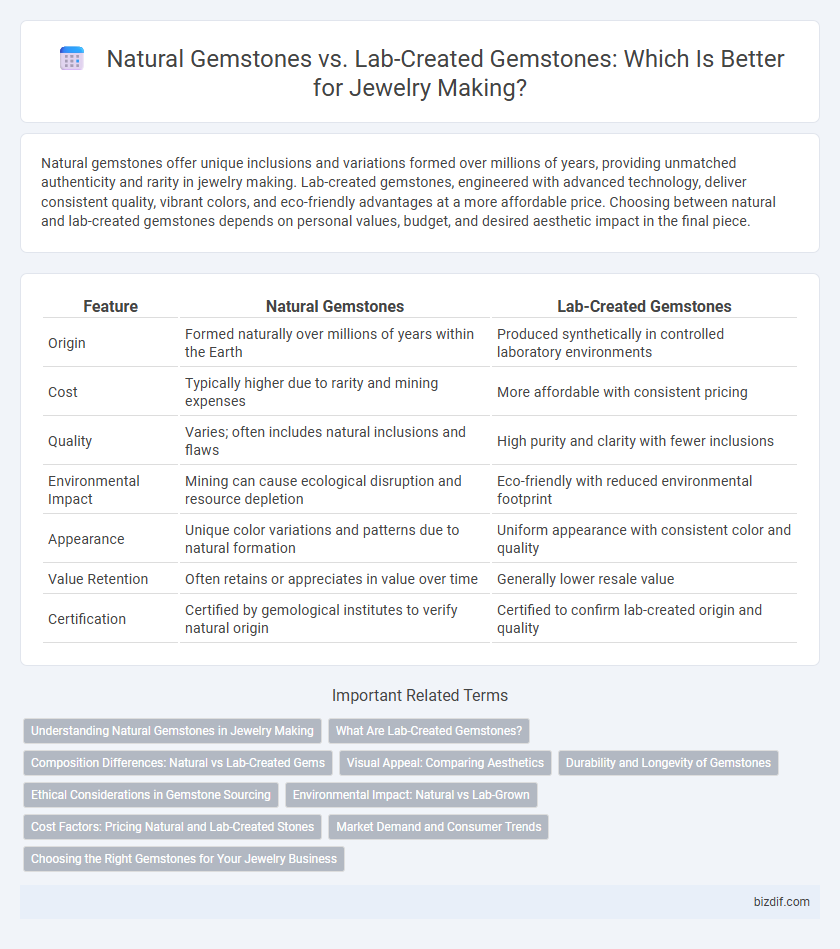Natural gemstones offer unique inclusions and variations formed over millions of years, providing unmatched authenticity and rarity in jewelry making. Lab-created gemstones, engineered with advanced technology, deliver consistent quality, vibrant colors, and eco-friendly advantages at a more affordable price. Choosing between natural and lab-created gemstones depends on personal values, budget, and desired aesthetic impact in the final piece.
Table of Comparison
| Feature | Natural Gemstones | Lab-Created Gemstones |
|---|---|---|
| Origin | Formed naturally over millions of years within the Earth | Produced synthetically in controlled laboratory environments |
| Cost | Typically higher due to rarity and mining expenses | More affordable with consistent pricing |
| Quality | Varies; often includes natural inclusions and flaws | High purity and clarity with fewer inclusions |
| Environmental Impact | Mining can cause ecological disruption and resource depletion | Eco-friendly with reduced environmental footprint |
| Appearance | Unique color variations and patterns due to natural formation | Uniform appearance with consistent color and quality |
| Value Retention | Often retains or appreciates in value over time | Generally lower resale value |
| Certification | Certified by gemological institutes to verify natural origin | Certified to confirm lab-created origin and quality |
Understanding Natural Gemstones in Jewelry Making
Natural gemstones in jewelry making are valued for their unique formation through geological processes over millions of years, resulting in distinct inclusions and color variations that cannot be replicated. These gemstones offer authenticity and rarity that enhance the piece's value and storytelling appeal to collectors and connoisseurs. Understanding the origin, characteristics, and treatment of natural gemstones is essential for jewelers to ensure ethical sourcing and accurate appraisal in the market.
What Are Lab-Created Gemstones?
Lab-created gemstones are synthetic stones produced in controlled environments that mimic natural geological processes, resulting in chemically, physically, and optically identical gems to their natural counterparts. These gemstones offer consistent quality, ethical sourcing, and often lower costs while maintaining the same brilliance and durability as natural stones. Advances in technology such as hydrothermal and flame fusion methods enable the creation of a wide variety of gemstones including diamonds, sapphires, and emeralds.
Composition Differences: Natural vs Lab-Created Gems
Natural gemstones form over millions of years through geological processes, containing unique mineral inclusions and trace elements that contribute to their distinct composition and color variations. Lab-created gemstones are synthesized using advanced techniques like hydrothermal or flame fusion methods, resulting in chemically identical crystals with fewer impurities and more consistent clarity. Understanding the composition differences is crucial for jewelers and consumers seeking authenticity, durability, and value in gemstone jewelry.
Visual Appeal: Comparing Aesthetics
Natural gemstones exhibit unique color variations and inclusions that create distinct visual depth, enhancing their aesthetic charm in jewelry making. Lab-created gemstones offer consistent clarity and vibrant, uniform colors due to controlled manufacturing processes, ensuring flawless appearance. Both types provide visually appealing options, with natural stones prized for their individuality and lab-created stones favored for precision and perfection in design.
Durability and Longevity of Gemstones
Natural gemstones exhibit unique inclusions and structural variances that enhance their durability over time, often maintaining their brilliance and hardness for centuries. Lab-created gemstones, synthesized under controlled conditions, generally possess fewer impurities and can demonstrate comparable or even superior hardness and resistance to scratching. Both types benefit from proper care, but natural stones often develop a distinct patina that contributes to their charm and perceived longevity in fine jewelry.
Ethical Considerations in Gemstone Sourcing
Natural gemstones often involve complex ethical considerations due to mining practices that can lead to environmental degradation and exploitative labor conditions. Lab-created gemstones provide a sustainable and ethically responsible alternative by eliminating the need for mining, reducing ecological impact, and ensuring transparent production processes. Consumers increasingly prioritize ethically sourced jewelry, making lab-created gems a preferred choice for reducing social and environmental harm.
Environmental Impact: Natural vs Lab-Grown
Natural gemstones require extensive mining operations that often result in habitat destruction, water pollution, and significant carbon emissions, impacting ecosystems adversely. Lab-created gemstones, produced in controlled environments, minimize land disruption and reduce resource consumption, leading to a lower environmental footprint. Sustainable jewelry brands increasingly favor lab-grown gems to support eco-friendly practices and reduce the ecological consequences associated with traditional gemstone mining.
Cost Factors: Pricing Natural and Lab-Created Stones
Natural gemstones typically command higher prices due to their rarity, unique inclusions, and the extensive mining process involved. Lab-created gemstones are more affordable, benefiting from controlled production environments that reduce costs, increase yield, and minimize environmental impact. Pricing depends significantly on factors such as clarity, color, carat weight, and market demand, with natural stones often holding greater long-term value.
Market Demand and Consumer Trends
Market demand for natural gemstones remains robust due to their rarity, unique inclusions, and perceived higher value, driving steady consumer interest in traditional jewelry collections. Lab-created gemstones gain traction through affordability, ethical sourcing, and consistent quality, appealing to environmentally conscious and budget-sensitive buyers. Consumer trends indicate a growing preference for sustainable jewelry, boosting the popularity of lab-created options alongside continued appreciation for natural gem authenticity.
Choosing the Right Gemstones for Your Jewelry Business
Natural gemstones offer unique variations and rarity that appeal to customers seeking exclusive jewelry pieces, while lab-created gemstones provide consistent quality and ethical sourcing at a lower cost. Prioritizing factors like customer preference, budget, and sustainability goals helps jewelry businesses select gemstones that align with their brand values. Understanding the differences in durability, appearance, and price between natural and lab-created options empowers informed decisions to maximize sales and satisfaction.
Natural gemstones vs lab-created gemstones Infographic

 bizdif.com
bizdif.com